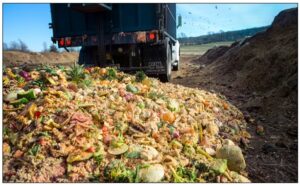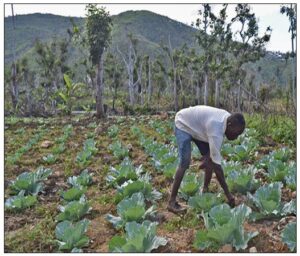Why compost food waste?
Food waste that is not composted generally goes directly to a landfill. As landfills fill up and close at an alarming rate, waste disposal and tipping fees to the businesses and institutions generating the waste will continue to climb. Once in the landfill, organic matter may react with other materials and create toxic leachate.

Food waste placed in an airtight landfill stops the earth natural cycle of decomposition. This cycle plays a crucial role in the health of our environment. This percentage can be much higher for tourist intensive areas. More than 72 percent of all materials entering landfills can be diverted through composting.
Composting provides a way in which solid wastes, water quality, and agricultural concerns can be joined. An increasing number of communities, businesses, institutions, and individuals are expected to turn to composting to divert materials from landfills and to lower waste management costs.
Although waste stream managers view composting primarily as a means to divert materials from disposal facilities, the environmental benefits, including reduction in water pollution, and the economic benefits to farmers, gardeners, and landscapers can be substantial.
Benefits of compost to the Environment and Agriculture
Environment
- Water and soil conservation.
- Protects groundwater quality.
- Minimizes odours from agricultural areas.
- Avoids methane production and leachate formation in landfills by diverting organics from landfills into compost.
- Prevents erosion and turf loss on roadsides, hillsides, playing fields and golf courses.
- Drastically reduces the need for pesticides and fertilizers.
- Binds heavy metals and prevents them from migrating to water resources, being absorbed by plants, or being bio-available to humans.
- Off-farm materials can be brought in and added to manure to make compost.
- Facilitates reforestation, wetlands restoration, and wildlife habitat revitalization efforts by amending contaminated, compacted and marginal soils.
- Off-farm materials can be brought in and added to manure to make compost.
- Composted manure weights about one-fourth as much as raw manure per ton.
Agriculture
- Long-term stable organic matter source.
- Buffers soil pH levels.
- Adds organic matter, humus and cation exchange capacity to regenerate poor soils.
- Suppresses certain plant diseases and parasites and kills weed seeds.
- Increases yield and size in some crops.
- Increases length and concentration of roots in some crops.
- Increases soil nutrient content and water holding capacity of sandy soils and water infiltration of clay soils.

- Reduces fertilizer requirements.
- Restores soil structure after natural soil microorganisms have been reduced by the use of chemical fertilizers; compost is a soil innoculant.
- Increases earthworm populations in soil.
- Provides slow, gradual release of nutrients, reducing loss from contaminated soils.
- Reduces water requirements and irrigation.
- Provides opportunity for extra income; high quality compost can be sold at a premium price in established markets.
- Moves manure to non-traditional markets that do not exist for raw manure.
- Brings higher prices for organically grown crops.
- Minimizes odours from agricultural areas.
What must you know to make and monitor food waste compost?
Proper nutrient mix, or carbon to nitrogen ratio (C:N) is important for bacteria to process organic material into compost. The optimum ratio to begin composting is 30:1.If the ratio increases decomposition is slow, if the ratio decreases foul odours and nitrogen loss can occur. Food waste is typically 15:1, fruit waste 35:1, leaves 60:1, bark 100:1, and sawdust 500:1.
A moisture content of 60 percent is optimal for microorganisms to breakdown the compost. Moisture contents above 70 percent create anaerobic conditions, slow down the process and can create foul odours. Moisture below 50 percent also slows down the decomposition process. The moisture content of fresh food waste is 80 to 90 percent, sawdust is 25 percent, and yard waste is 70 percent. Compost with a proper moisture content will form a clump and will slightly wet your hand when squeezed. If the clump drips water, it is too wet and may require additional aeration or more bulking agent. If the compost falls through your fingers, it is too dry and may need water additions or more food waste.
Aeration or oxygen is essential for optimum microorganism populations to effectively breakdown the composting material. This can be done by turning, mixing the use of blowers, fans, aeration tubes, aeration holes, or raising the compost off the ground.

Particle size can affect the rate of decomposition of compost. The smaller the particles the more aeration the compost receives and microorganisms can break down smaller pieces faster. This can be accomplished by shredding, chipping, chopping, or cutting composted materials before they enter the compost pile.
PH levels from 6.0 to 7.8 are considered high quality compost. Proper C:N ratios should create optimum pH levels. Starting with a fairly neutral pH will ensure high levels of microorganisms for efficient decomposition.
Temperature of the compost is important while biological activity takes place in the decomposition process. Lower outside temperature slow down the process, while warmer conditions speed up the process. Meso-phillic bacteria function between 50 and 113 degrees F to begin the composting process. Thermo-phillic bacteria take over and thrive between 113 to 158 degrees F. These high temperatures are what destroy weed seeds and pathogens in the compost. Some composting manures can reach temperatures of 200 degrees F. However, temperatures above 158 degrees F may char the compost or create conditions suitable for spontaneous combustion.
What is the future in composting?
- As landfill space and openings decrease, there will undoubtedly be more pressure to compost food waste along with all organic waste. As tipping fees increase and it becomes prohibitively more expensive to landfill, composting may be an attractive financial alternative as well as a value-added opportunity.
- Laws already exist in many states that require counties to compost. As agricultural practices continue to exhaust soils and deplete organic matter, compost will be integral in maintaining soil fertility.
- Landscape, nursery, public agency and homeowner demand for high quality compost continues to increase. Compost is an essential product in increasing amounts of land reclamation projects.
- Compost also plays an important role in more environmentally regulated and environmentally aware agricultural systems. For many livestock, poultry, and sustainable and alternative agriculture operations, compost and composting may be the best choice as well as opportunity for added income.
For more information contact us;
Green-rich Grow India Private Limited
Chennai-600095
Ph: 04423781844
www.mygreenbin.in/ solutions@mygreenbin.in


